一、什么是事件分发
所谓事件分发,就是将一次完整的点击所包含的点击事件传递到某个具体的View或ViewGroup,让该View或该ViewGroup处理它(消费它)。分发是从上往下(父到子)依次传递的,其中可能经过的对象有最上层Activity,中间层ViewGroup,最下层View。
二、Activity的层次结构
源码查找:
1.自己的Activity的setContentView()方法
@Override
protected void onCreate(Bundle savedInstanceState) {
super.onCreate(savedInstanceState);
setContentView(R.layout.activity_event_distribution);
}
2.跳转到Activity.java的setContentView()方法,可以看到,调用了getWindow()的方法
public void setContentView(@LayoutRes int layoutResID) {
getWindow().setContentView(layoutResID);
initWindowDecorActionBar();
}
3.Activity.java的mWindow来自PhoneWindow
mWindow = new PhoneWindow(this, window, activityConfigCallback);
4.PhoneWindow.java-->setContentView()--> installDecor(),在PhoneWindow中调用了installDecor()方法
@Override
public void setContentView(int layoutResID) {
// Note: FEATURE_CONTENT_TRANSITIONS may be set in the process of installing the window
// decor, when theme attributes and the like are crystalized. Do not check the feature
// before this happens.
if (mContentParent == null) {
installDecor(); //继续执行
} else if (!hasFeature(FEATURE_CONTENT_TRANSITIONS)) {
mContentParent.removeAllViews();
}
..................
5.PhoneWindow.java-->setContentView()--> installDecor()--> generateLayout(mDecor),在 installDecor()中又继续执行了generateLayout(mDecor)方法。
mContentParent = generateLayout(mDecor);
6.PhoneWindow.java-->generateLayout()
ViewGroup generateLayout(DecorView decor)
7.PhoneWindow.java-->generateLayout()--> int layoutResource,layoutResource根据不同情况,返回不同的资源文件,也就是布局文件。
int layoutResource;
8.PhoneWindow.java-->generateLayout()-->R.layout.screen_title; 拿出一个常用的布局文件,screen_title.xml
layoutResource = R.layout.screen_title;
9.screen_title.xml的代码, ViewStub是用来显示ActionBar的,另外两个FrameLayout,一个显示TitleView,一个显示ContentView,平时写的内容,正是ContentView。
<LinearLayout xmlns:android="http://schemas.android.com/apk/res/android"
android:orientation="vertical"
android:fitsSystemWindows="true">
<!-- Popout bar for action modes -->
<ViewStub android:id="@+id/action_mode_bar_stub"
android:inflatedId="@+id/action_mode_bar"
android:layout="@layout/action_mode_bar"
android:layout_width="match_parent"
android:layout_height="wrap_content"
android:theme="?attr/actionBarTheme" />
<FrameLayout
android:layout_width="match_parent"
android:layout_height="?android:attr/windowTitleSize"
style="?android:attr/windowTitleBackgroundStyle">
<TextView android:id="@android:id/title"
style="?android:attr/windowTitleStyle"
android:background="@null"
android:fadingEdge="horizontal"
android:gravity="center_vertical"
android:layout_width="match_parent"
android:layout_height="match_parent" />
</FrameLayout>
<FrameLayout android:id="@android:id/content"
android:layout_width="match_parent"
android:layout_height="0dip"
android:layout_weight="1"
android:foregroundGravity="fill_horizontal|top"
android:foreground="?android:attr/windowContentOverlay" />
</LinearLayout>
如以下结构图:
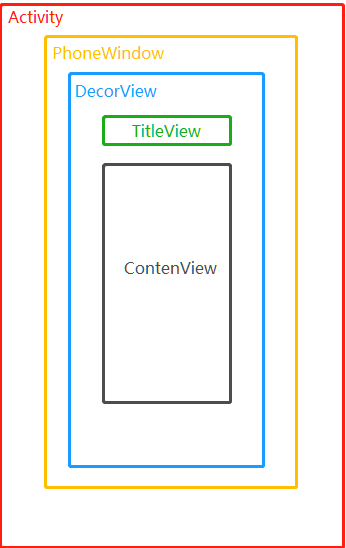
三、事件分发涉及到的主要方法
涉及到的方法
@Override
public boolean dispatchTouchEvent(MotionEvent ev) {
//分发事件
return super.dispatchTouchEvent(ev);
}
@Override
public boolean onInterceptTouchEvent(MotionEvent ev) {
//拦截事件
return super.onInterceptTouchEvent(ev);
}
@Override
public boolean onTouchEvent(MotionEvent event) {
//消费事件
return super.onTouchEvent(event);
}
Activity涉及到的方法:dispatchTouchEvent()、onTouchEvent()
ViewGroup涉及到的方法:dispatchTouchEvent()、onInterceptTouchEvent()
View涉及到的方法:dispatchTouchEvent()、onTouchEvent()
四、事件分发流程
1.Activity把事件分发到ViewGroup
(1)事件传递
每一次事件分发,都是从dispatchTouchEvent()开始的。
1)查看Activity的源码,调用了getWindow().superDispatchTouchEvent(ev)
public boolean dispatchTouchEvent(MotionEvent ev) {
if (ev.getAction() == MotionEvent.ACTION_DOWN) {
onUserInteraction();
}
if (getWindow().superDispatchTouchEvent(ev)) {
return true;
}
return onTouchEvent(ev);
}
2)在Activity.java中可以看到,所以getWindow().superDispatchTouchEvent(ev)实际上是调用了PhoneWindow.java中的superDispatchTouchEvent(ev)方法。
public Window getWindow() {
return mWindow;
}
mWindow = new PhoneWindow(this, window, activityConfigCallback); //mWindow的定义
3)然后再看PhoneWindow.java中的superDispatchTouchEvent(ev)方法,是调用DecorView.java的mDecor.superDispatchTouchEvent(event)
@Override
public boolean superDispatchTouchEvent(MotionEvent event) {
return mDecor.superDispatchTouchEvent(event);
}
4)而DecorView是继承FrameLayout,再继承ViewGroup的
private DecorView mDecor; //实例对象
class DecorView extends FrameLayout; //继承FrameLayout
FrameLayout extends ViewGroup; //继承ViewGroup
5)从上面四步来分析,Avtivity的getWindow().superDispatchTouchEvent()方法最后调用的是ViewGroup的dispatchTouchEvent()方法,从而实现了事件从Activity的dispatchTouchEvent()向下传递到ViewGroup的dispatchTouchEvent()方法。
(2)总结
6)返回值分析。
- 如果Avtivity的
getWindow().superDispatchTouchEvent()返回true,则Avtivity的dispatchTouchEvent(),也会返回true,表示点击事件顺利分发给ViewGroup,由ViewGroup继续进行下一层的分发,Avtivity的分发任务结束。 - 如果返回false,表示此次点击事件由Avtivity层消费,会执行Avtivity的
onTouchEvent(),无论onTouchEvent()这个方法返回的是true或者false,本次的事件分发都结束了。
(3)流程图
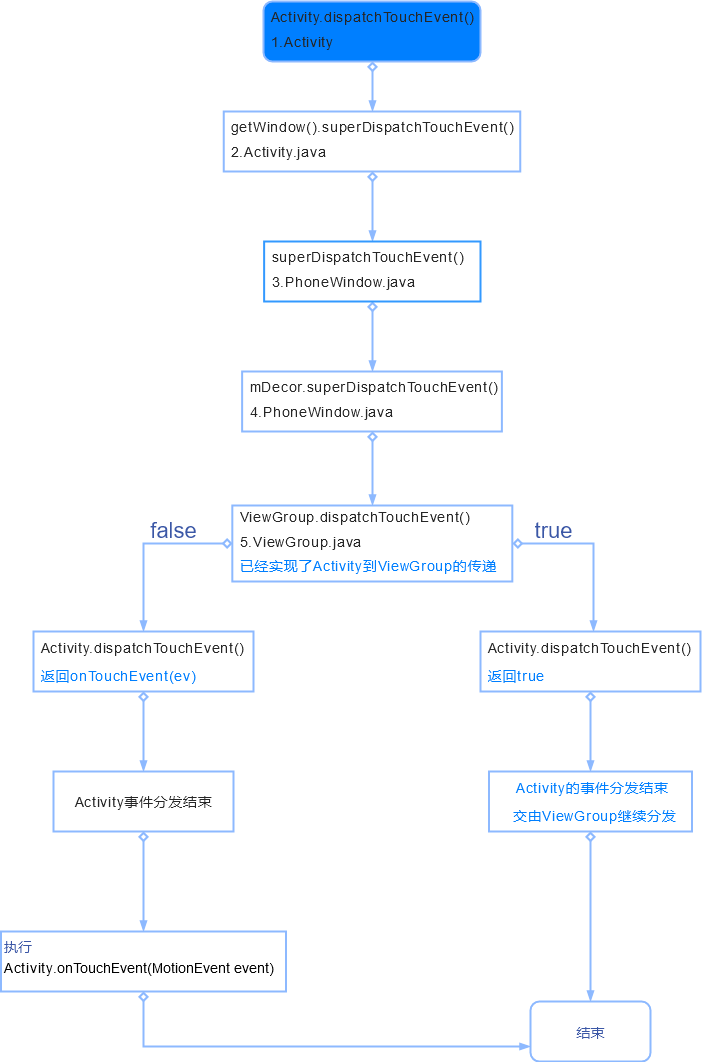
2.ViewGroup把事件分发到ViewGroup或View
(1)事件拦截
ViewGroup.java中的部分代码
ViewGroup-->dispatchTouchEvent()
public boolean dispatchTouchEvent(MotionEvent ev) {
if (!disallowIntercept) {
intercepted = onInterceptTouchEvent(ev);
ev.setAction(action); // restore action in case it was changed
} else {
intercepted = false;
}
}
方法中使用了onInterceptTouchEvent(ev)方法
- 如果返回true,则表示ViewGroup拦截此次事件。
- 如果返回false,则表示ViewGroup不拦截,事件继续往下分发。
onInterceptTouchEvent(ev)默认返回不拦截,可以在ViewGroup中重写改方法来拦截事件。- 不拦截事件,则会调用ViewGroup的onTouchEvent()来处理点击事件,把事件消费掉。
(2)分发
这个源码中,使用到了intercepted这个变量,主要作用是来遍历子ViewGroup和View,
- 当intercepted为false的时候,遍历子ViewGroup和子View,因为这个事件没有被消费掉,继续分发到子ViewGroup和子View。
- 当intercepted为true的时候,该事件已经被消费,不会继续往下分发,也不会遍历子ViewGroup和子View,也不会执行if语句里面的方法。
- 进入if语句中判断点击事件的触摸范围(焦点)是否属于某个子ViewGroup或者子View。
- 如果触摸范围属于子View,则调用子View的dispatchTouchEvent()方法。
- 如果触摸范围属于子ViewGroup,则继续遍历下一层的ViewGroup或者View。
- 遍历到最下层的View,还是找不到消费此处事件的View,则依次回调上一层的ViewGroup的onTouchEvent()方法,直到回调到Activity的onTouchEvent()方法。
// Check for interception.
final boolean intercepted;
if (!canceled && !intercepted) {
// If the event is targeting accessibility focus we give it to the
// view that has accessibility focus and if it does not handle it
// we clear the flag and dispatch the event to all children as usual.
// We are looking up the accessibility focused host to avoid keeping
// state since these events are very rare.
View childWithAccessibilityFocus = ev.isTargetAccessibilityFocus()
? findChildWithAccessibilityFocus() : null;
(3)流程图
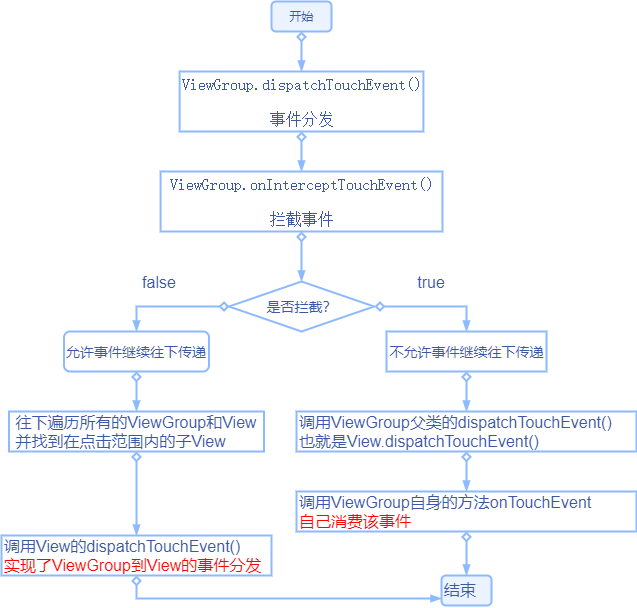
3.View的事件分发
(1)分析
View的dispatchTouchEvent()的源码
public boolean dispatchTouchEvent(MotionEvent event) {
// If the event should be handled by accessibility focus first.
if (event.isTargetAccessibilityFocus()) {
// We don't have focus or no virtual descendant has it, do not handle the event.
if (!isAccessibilityFocusedViewOrHost()) {
return false;
}
// We have focus and got the event, then use normal event dispatch.
event.setTargetAccessibilityFocus(false);
}
boolean result = false;
if (mInputEventConsistencyVerifier != null) {
mInputEventConsistencyVerifier.onTouchEvent(event, 0);
}
final int actionMasked = event.getActionMasked();
if (actionMasked == MotionEvent.ACTION_DOWN) {
// Defensive cleanup for new gesture
stopNestedScroll();
}
if (onFilterTouchEventForSecurity(event)) {
if ((mViewFlags & ENABLED_MASK) == ENABLED && handleScrollBarDragging(event)) {
result = true;
}
//noinspection SimplifiableIfStatement
ListenerInfo li = mListenerInfo;
if (li != null && li.mOnTouchListener != null
&& (mViewFlags & ENABLED_MASK) == ENABLED
&& li.mOnTouchListener.onTouch(this, event)) {
result = true;
}
if (!result && onTouchEvent(event)) {
result = true;
}
}
if (!result && mInputEventConsistencyVerifier != null) {
mInputEventConsistencyVerifier.onUnhandledEvent(event, 0);
}
// Clean up after nested scrolls if this is the end of a gesture;
// also cancel it if we tried an ACTION_DOWN but we didn't want the rest
// of the gesture.
if (actionMasked == MotionEvent.ACTION_UP ||
actionMasked == MotionEvent.ACTION_CANCEL ||
(actionMasked == MotionEvent.ACTION_DOWN && !result)) {
stopNestedScroll();
}
return result;
}
- 在View的dispatchTouchEvent()方法中首先会调用
onTouch()方法,如果onTouch()方法能够消费该事件,就会直接返回True,从而直接结束View的dispatchTouchEvent()方法,不再执行onTouchEvent()方法; - 如果onTouch()方法不能消费该事件,就会返回False,从而继续执行
onTouchEvent``()方法。 - 如果onTouchEvent()能够消费该事件,就会返回True从而直接结束dispatchTouchEvent()方法。
- 如果onTouchEvent()方法也不能消费该事件,就会返回默认的False从而回调到上一层
ViewGroup的onTouchEvent()方法,直到回调到Activity的onTouchEvent``()方法。
(2)流程图
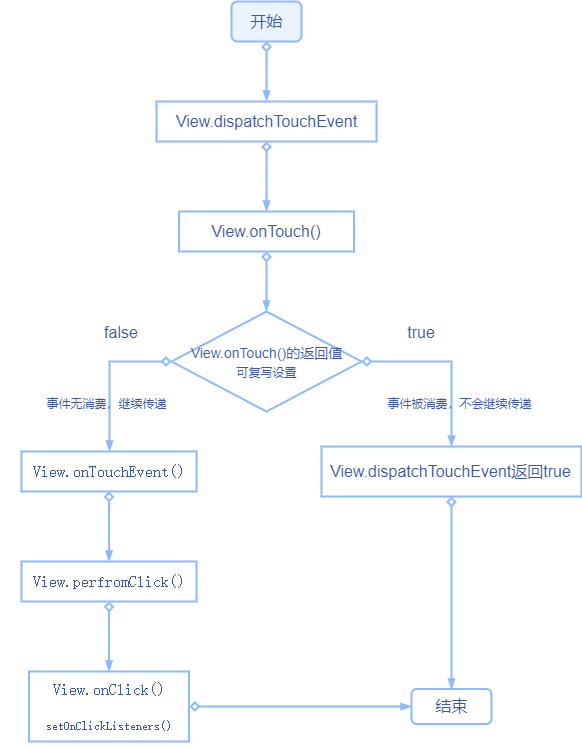
五、具体例子
(0)测试代码
共有三种类型和四个测试代码
Activity:EventDistributionActivity
ViewGroup:EventDistributionLinearLayout1、EventDistributionLinearLayout2
View:EventDistributionButton
分别代码:
EventDistributionActivity.java
public class EventDistributionActivity extends BaseActivity {
Button mBtn;
@Override
protected void onCreate(Bundle savedInstanceState) {
super.onCreate(savedInstanceState);
setContentView(R.layout.activity_event_distribution);
mBtn = findViewById(R.id.btn);
OnClick();
}
public void OnClick() {
mBtn.setOnClickListener(new View.OnClickListener() {
@Override
public void onClick(View v) {
Log.v("showLog", "按钮被点击!");
}
});
mBtn.setOnTouchListener(new View.OnTouchListener() {
@Override
public boolean onTouch(View v, MotionEvent event) {
boolean dis = false;
Log.v("showLog", "Button.Touch()=" + dis);
return dis;
}
});
}
@Override
public boolean dispatchTouchEvent(MotionEvent ev) {
//分发事件
boolean dis = super.dispatchTouchEvent(ev);
Log.v("showLog", "Activity.dispatchTouchEvent()=" + dis);
return dis;
}
@Override
public boolean onTouchEvent(MotionEvent event) {
//处理事件
boolean dis = super.onTouchEvent(event);
Log.v("showLog", "Activity.onTouchEvent()=" + dis);
return dis;
}
}
EventDistributionLinearLayout1.java
public class EventDistributionLinearLayout1 extends LinearLayout {
public EventDistributionLinearLayout1(Context context, AttributeSet attrs) {
super(context, attrs);
}
@Override
public boolean dispatchTouchEvent(MotionEvent ev) {
//分发事件
boolean dis = super.dispatchTouchEvent(ev);
Log.v("showLog", "LinearLayout1.dispatchTouchEvent()=" + dis);
return dis;
}
@Override
public boolean onInterceptTouchEvent(MotionEvent ev) {
//拦截事件
boolean dis = super.onInterceptTouchEvent(ev);
Log.v("showLog", "LinearLayout1.onInterceptTouchEvent()=" + dis);
return dis;
}
@Override
public boolean onTouchEvent(MotionEvent event) {
//消费事件
boolean dis = super.onTouchEvent(event);
Log.v("showLog", "LinearLayout1.onTouchEvent()=" + dis);
return dis;
}
}
EventDistributionLinearLayout2.java
public class EventDistributionLinearLayout2 extends LinearLayout {
public EventDistributionLinearLayout2(Context context, AttributeSet attrs) {
super(context, attrs);
}
@Override
public boolean dispatchTouchEvent(MotionEvent ev) {
//分发事件
boolean dis = super.dispatchTouchEvent(ev);
Log.v("showLog", "LinearLayout2.dispatchTouchEvent()=" + dis);
return dis;
}
@Override
public boolean onInterceptTouchEvent(MotionEvent ev) {
//拦截事件
boolean dis = super.onInterceptTouchEvent(ev);
dis = true;
Log.v("showLog", "LinearLayout2.onInterceptTouchEvent()=" + dis);
return dis;
}
@Override
public boolean onTouchEvent(MotionEvent event) {
//消费事件
boolean dis = super.onTouchEvent(event);
Log.v("showLog", "LinearLayout2.onTouchEvent()=" + dis);
return dis;
}
}
EventDistributionButton.java
public class EventDistributionButton extends Button {
public EventDistributionButton(Context context, AttributeSet attrs) {
super(context, attrs);
}
@Override
public boolean dispatchTouchEvent(MotionEvent event) {
//分发事件
boolean dis = super.dispatchTouchEvent(event);
Log.v("showLog", "Button.dispatchTouchEvent()=" + dis);
return dis;
}
@Override
public boolean onTouchEvent(MotionEvent event) {
//消费事件
boolean dis = super.onTouchEvent(event);
Log.v("showLog", "Button.onTouchEvent()=" + dis);
return dis;
}
@Override
public boolean performClick() {
boolean dis = super.performClick();
Log.v("showLog", "Button.performClick()="+dis);
return dis;
}
}
activity_event_distribution.xml
<?xml version="1.0" encoding="utf-8"?>
<com.lanjiabin.systemtest.event.EventDistributionLinearLayout1 xmlns:android="http://schemas.android.com/apk/res/android"
xmlns:app="http://schemas.android.com/apk/res-auto"
xmlns:tools="http://schemas.android.com/tools"
android:layout_width="match_parent"
android:layout_height="match_parent"
android:orientation="vertical"
tools:context=".event.EventDistributionActivity">
<com.lanjiabin.systemtest.event.EventDistributionLinearLayout2
android:layout_width="match_parent"
android:layout_height="match_parent"
android:orientation="vertical">
<com.lanjiabin.systemtest.event.EventDistributionButton
android:background="@drawable/button_color_circle_shape1"
android:id="@+id/btn"
android:layout_width="wrap_content"
android:layout_height="wrap_content"
android:layout_gravity="center"
android:layout_marginTop="300dp"
android:text="点击" />
</com.lanjiabin.systemtest.event.EventDistributionLinearLayout2>
</com.lanjiabin.systemtest.event.EventDistributionLinearLayout1>
效果图:一个LinearLayout1包含LinearLayout2再包含一个Button
界面只有一个按钮
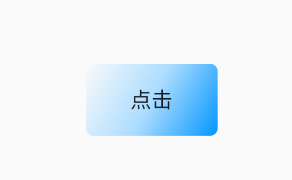
(1)测试1
测试用例:按钮消费事件,和空白处不消费事件
按住按钮不松开,事件被Button的onTouchEvent()消费
LinearLayout1.onInterceptTouchEvent()=false
LinearLayout2.onInterceptTouchEvent()=false
Button.Touch()=false
Button.onTouchEvent()=true
Button.dispatchTouchEvent()=true
LinearLayout2.dispatchTouchEvent()=true
LinearLayout1.dispatchTouchEvent()=true
Activity.dispatchTouchEvent()=true
按住空白处不松开,没有事件被消费
LinearLayout1.onInterceptTouchEvent()=false
LinearLayout2.onInterceptTouchEvent()=false
LinearLayout2.onTouchEvent()=false
LinearLayout2.dispatchTouchEvent()=false
LinearLayout1.onTouchEvent()=false
LinearLayout1.dispatchTouchEvent()=false
Activity.onTouchEvent()=false
Activity.dispatchTouchEvent()=false
(2)测试2
测试用例:在LinearLayout2处截断
修改代码:EventDistributionLinearLayout2.java
@Override
public boolean onInterceptTouchEvent(MotionEvent ev) {
//拦截事件
boolean dis = super.onInterceptTouchEvent(ev);
dis = true;
Log.v("showLog", "LinearLayout2.onInterceptTouchEvent()=" + dis);
return dis;
}
按住按钮不松开:事件截断生效,将不会继续遍历下层的ViewGroup或者View,所以日志中看不到Button的日志打印。
LinearLayout1.onInterceptTouchEvent()=false
LinearLayout2.onInterceptTouchEvent()=true //截断生效
LinearLayout2.onTouchEvent()=false
LinearLayout2.dispatchTouchEvent()=false
LinearLayout1.onTouchEvent()=false
LinearLayout1.dispatchTouchEvent()=false
Activity.onTouchEvent()=false
Activity.dispatchTouchEvent()=false
(3)测试3
测试用例:在View中onTouch()中返回true
也就是在Button中设置onTouch()返回true,则不会产生点击事件,完整的点击事件是被按下和松开的,所以上面没有点击按钮的监听事件的打印日志。
首先,看看完整的点击事件日志,去掉先前测试的改变的代码。
LinearLayout1.onInterceptTouchEvent()=false
LinearLayout2.onInterceptTouchEvent()=false
Button.Touch()=false
Button.onTouchEvent()=true //触摸按下事件被消费
Button.dispatchTouchEvent()=true
LinearLayout2.dispatchTouchEvent()=true
LinearLayout1.dispatchTouchEvent()=true
Activity.dispatchTouchEvent()=true //触摸按下的事件处理结束
LinearLayout1.onInterceptTouchEvent()=false //开始触摸i抬起的事件
LinearLayout2.onInterceptTouchEvent()=false
Button.Touch()=false
Button.onTouchEvent()=true //触摸抬起的事件被消费
Button.dispatchTouchEvent()=true
LinearLayout2.dispatchTouchEvent()=true
LinearLayout1.dispatchTouchEvent()=true
Activity.dispatchTouchEvent()=true
按钮被点击! //onClick
Button.performClick()=true
开始测试用例:
修改代码:
EventDistributionActivity.java,将boolean dis = false;修改为boolean dis = true;
mBtn.setOnTouchListener(new View.OnTouchListener() {
@Override
public boolean onTouch(View v, MotionEvent event) {
boolean dis = true;
Log.v("showLog", "Button.Touch()=" + dis);
return dis;
}
});
按下和松开按钮:可以看到,事件被Button.Touch()消费了,因为在Touch()返回了true,事件没有继续传递下去,所以onClick事件没有被触发,没有生效。
LinearLayout1.onInterceptTouchEvent()=false
LinearLayout2.onInterceptTouchEvent()=false
Button.Touch()=true //触摸事件被消费
Button.dispatchTouchEvent()=true
LinearLayout2.dispatchTouchEvent()=true
LinearLayout1.dispatchTouchEvent()=true
Activity.dispatchTouchEvent()=true //触摸按下事件处理完毕
LinearLayout1.onInterceptTouchEvent()=false
LinearLayout2.onInterceptTouchEvent()=false
Button.Touch()=true
Button.dispatchTouchEvent()=true
LinearLayout2.dispatchTouchEvent()=true
LinearLayout1.dispatchTouchEvent()=true
Activity.dispatchTouchEvent()=true
编程中我们会遇到多少挫折?表放弃,沙漠尽头必是绿洲。